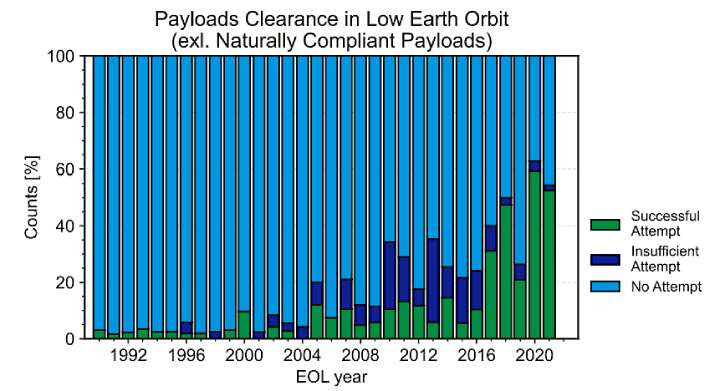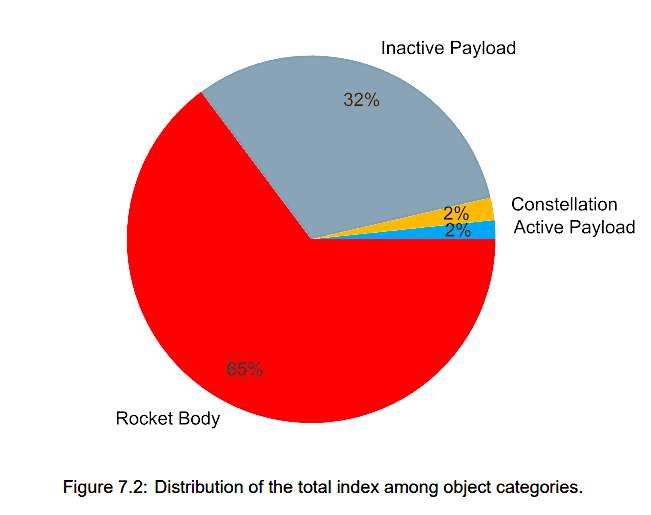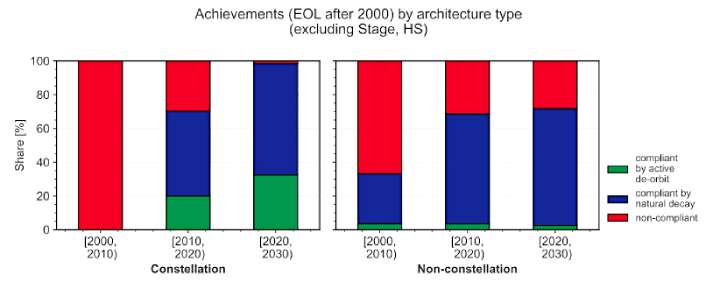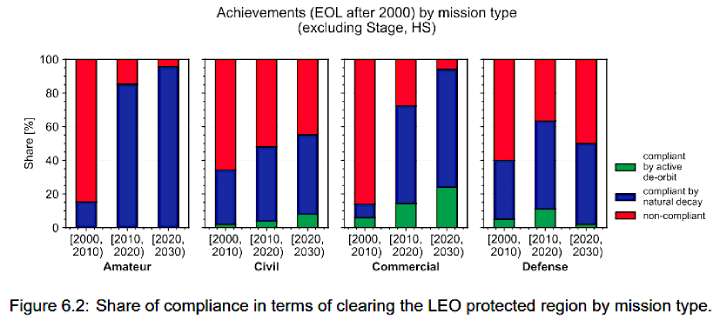 (Source: ESA 2023 Space Environment Report)
(Source: ESA 2023 Space Environment Report)
PARIS — An annual assessment of space debris-mitigation efforts worldwide found broad but still-insufficient improvement in satellite operators’ compliance with international guidelines.
The 2023 edition of the “Space Environment Report” published by the 22-nation European Space Agency (ESA) shows a gradual adoption of practices including end-of-life disposal of satellites. But it also shows that far too many operators in low Earth orbit — below 2,000 kilometers — are doing either nothing or too little to remove their spacecraft from these increasingly crowded orbital highways.
ESA derives its annual data from Europe-based space-surveillance assets and those from U.S. STRATCOM, Russia’s JSC Vimpel Interstate Corp. and Keldysh Institute of Applied Mathematics; and the Royal Aircraft Establishment (RAE).
As was the case in previous years, this year’s assessment raises the question of whether making the end-of-life-disposal guidelines stricter — such as the U.S. Federal Communications Commission’s new 5-year deadline — is valuable when so many satellites are still left in orbit beyond the current 25-year recommendation.
If a large portion of highway drivers are exceeding the current speed limit, the utility of lowering the limit is debatable.
“Whereas adoption of, and compliance to, space debris mitigation practices at a global level is noted as slowly increasing, it is important to note that the successful implementation is still at a too low level to ensure a sustainable environment in the long-run,” ESA’s June 2023 report concludes.
 (Source: 2023 Space Environment Report)
(Source: 2023 Space Environment Report)
It was 21 years ago that the world’s major space-faring nations, coming together in the Inter-Agency Debris Coordinating Committee (IADC) first published its non-binding guidelines on post-mission disposal of satellites. Adherence has been irregular, to say the least.
The arrival of large constellations of satellites in low Earth orbit has changed the space situational awareness game and specifically the post-mission disposal statistics.
 Constellation here is defined as a group of 20 satellites or more. (Source: 2023 Space Environment Report)
Constellation here is defined as a group of 20 satellites or more. (Source: 2023 Space Environment Report)
The largest commercial constellation, SpaceX’s Starlink, operates at orbits low enough so that SpaceX need do nothing to ensure they meet the end-of-life disposal guidelines. That’s not true for OneWeb, whose satellites are at 1,200 kilometers and require special disposal measures.
The Starlink and OneWeb satellites also carry on-board propulsion, allowing them to maneuver to avoid possible collisions with trackable debris or other satellites. This is not the case for many satellites in low Earth orbit, particularly the smaller ones.
Lots of large constellations in low Earth orbit raises many issues relating to collision avoidance and the coordination of radio frequencies.
Some of the report’s findings:
— Constellation operators, as a whole, do better at post-mission disposal than operators of individual satellites in low Earth orbit. Constellations are defined as comprising at least 20 satellites.
 (Source: 2023 Space Environment Report)
(Source: 2023 Space Environment Report)
— Commercial operators do better than military operators in clearing their satellites from orbit on retirement.
— Ride-share passengers are still not informing the wider community about the whereabouts of their satellites after separation from rockets launching dozens of small satellites at a time. But they are getting better at this.
— About half of the larger satellites in low Earth orbits that are too high to rely on natural forces to deorbit within 25 years are either making no attempt at meeting this goal or do not succeed in attempts at post-mission disposal.
“The majority of larger payloads reaching the end of their mission since 2010 did so in orbits where they did not successfully remove themselves from,” ESA said.
 (Source: 2023 Space Environment Report)
(Source: 2023 Space Environment Report)
“Between 40 and 70% of all payload mass, excluding human spaceflight, estimated as reaching end-of-life during the last decade in the LEO protected region does so in orbits that are estimated to adhere to the space debris mitigation measures.”
This would include satellites whose orbit is low enough so that doing nothing on retirement will still meet the guidelines. The study found that 93% of all very small satellites — less than 10 kilograms — launched in the past 10 years are operated in orbits from which natural forces pull them into the atmosphere, where they disintegrate.
— Disposal of rocket bodies to remove them from the low orbit is becoming more common. “Between 60 and 85% of all rocket body mass reaching end-of-life during the last decade do so in orbits estimated to adhere to the space debris mitigation measures on protecting LEO,” the report said. “A significant amount of this is due to controlled re-entries after launch, a practice which increased from 10% to over 40% over the last decade.”
Read more from Space Intel Report.
